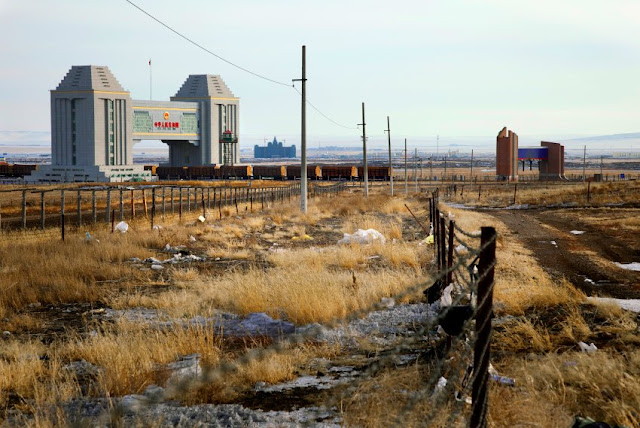China to Russia: Who's the Bitch Now?
Mirnaya was once a thriving garrison town with a movie theater, a kindergarten and a park. The Soviet army maintained a base here to keep an eye on neighboring China. Then the Soviet Union collapsed and the military left. To survive, those who stayed behind gradually dismantled and sold off what was left, piece by piece. First they removed the windows from the prefabricated buildings where the officers had once lived and sold them in Chita. Then they ripped radiators and pipes from the walls and sold them to scrap dealers, who then sold the metal in China. The buildings now stand like skeletons in the steppes, evidence of a ruined country. _Spiegel
China's border gate is to the left, above, and Russia's is to the right. A load of Russian lumber is moving into China. A lot of raw materials and natural resources have been moving from Russia into China, recently, where the Chinese turn the materials into finished products to sell at a significant markup.
The main thing going into Russia from China is Chinese settlers and investors, building Chinese colonies and outposts inside the very heart of Russia's source of wealth and economic power.
The border between the fallen superpower Russia and the People's Republic, which is gradually becoming a superpower, measures 3,645 kilometers, one of the longest borders in the world. And perhaps this border, where Europe's last offshoots encounter 1.3 billion Chinese, and where Christianity collides with Buddhism and Confucianism, is also one of the most important in the power struggles of the new century.
...Siberia, which covers three-quarters of the landmass of Russia, is home to only a quarter of the country's population: 38 million people. This is the equivalent of the population of Poland, except that Siberia is 40 times the size. It is a situation that many fear could once again spark the eternal rivalry between Russia and China, a rivalry that last produced military clashes in the 1960s.
Chinese investors have already bought a former tank factory in Chita, where they are now producing trucks. They already control the markets in Russian border towns, where they are the richest private business owners. "China invests more in the Russian Far East than our own government does," writes the Moscow newspaper Niezawisimaja Gazieta.
...Years ago Dmitry Rogozin, Russia's eloquent NATO ambassador, said half-jokingly that the Chinese would soon be "crossing the border in small groups of five million." And Vladimir Putin, shortly after being elected president, warned: "Unless we make a serious effort, the Russians in the border regions will have to speak Chinese, Japanese and Korean in a few decades." This hardly seems an exaggeration, given that there are six million Russians living in Eastern Siberia, compared with the 90 million living in China's northern provinces.
...Russian tourists heading to China to buy inexpensive goods are forced to wait up to 12 hours in their cars. These people, who work for distributors and are popularly known as "silk worms" or "camels," travel to China several times a month to bring goods to Russia: jeans and blouses, electric shavers and children's toys, athletic shoes made by a low-wage manufacturer called "Adidos" and chainsaws labeled "Stihl." They are pirated products, and are manufactured in southern China.
... the Chinese aren't just interested in Russian lumber. They also want Russian oil. Some 1,300 kilometers farther to the east, past empty steppes where a driver is likely to encounter no more than three cars an hour, is the small city of Skovorodino. It is the terminal point of the most expensive infrastructure project in the new Russia, a "pipeline with geopolitical significance," as Prime Minister Putin raves.
... _Spiegel


0 Comments:
Post a Comment
<< Home